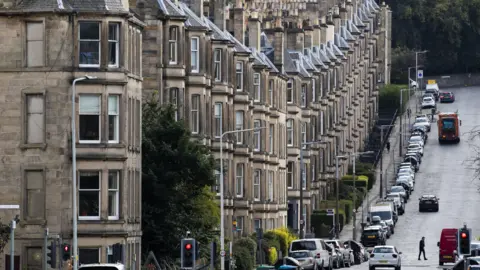Numbers in private rented homes on the rise - census
 Getty Images
Getty ImagesThe number of privately rented homes in Scotland has increased by almost 10% in a decade, according to the latest figures released from the 2022 census.
Over the same period the number of households in social rented properties dropped by 2.1%, the figures show.
The latest census showed the number of people who own their home outright has increased by 28.8% since 2011.
More than two thirds of households , particularly in the islands, were found to have more bedrooms than they required while some cities faced overcrowding.
The latest release of figures from the 2022 census showed there were 887,600 households in rented accommodation in Scotland.
Social rented households, such as council or housing association properties, were down to 564,500, a drop of 11,900 from the figure in the 2011 census.
However, there was a big increase in households renting privately, up 28,200 to 323,000.
The number of people in student accommodation or halls of residence increased by 68% - up 22,600 - in line with rising numbers of people studying in Scotland.
Meanwhile, the number of people living in care homes fell by 14.5% to 30,800.
The data showed there were 2,509,300 households in total, up 136,500 (5.8%) from the 2011 census. Figures previously released from the census have shown an increase in the number of people living alone.
On Census Day around two-thirds (63.2%) owned their home (1,585,800 households) and one third rented.
The number of households that owned their home outright increased to 851,100, almost 200,000 more than 2011 and 340,000 more than 2001.
National Record of Scotland, who released the data, said the majority of the increase was due to increases in older age groups.
Older homeowners are likely to have had longer to pay off their mortgage.
There were 135,200 more householders aged 65 and over who owned their home outright in 2022, compared to 2011.
Other data in the census suggested 70.3% of households had more bedrooms than required and just under one-third had at least two more bedrooms than they needed.
Island council areas tended to have more households with two more bedrooms than required while Glasgow and Dundee had the most overcrowding.
Almost a third of households in Scotland were living in a tenement or a purpose built block of flats (813,500).
The next most common accommodation type was detached houses 600,700 (23.9%) closely followed by semi-detached houses 584,800 (23.3%).
The figures showed there were 80,000 more households living in detached houses than in 2011.
Midlothian council area had the biggest percentage increase in households living in detached houses, up 44.9% (3,100).
The biggest numerical increase in detached houses was in Aberdeenshire (7,000) followed by South Lanarkshire (6,700).
There was a large increase in the number of households living in a tenement or purpose-built flat in Edinburgh (up 9,600).
But this was offset by decreases in several council areas including North Lanarkshire (down 3,900) and Glasgow City (down 2,300). Some of these decreases will be related to the closure and demolition of high-rises.
